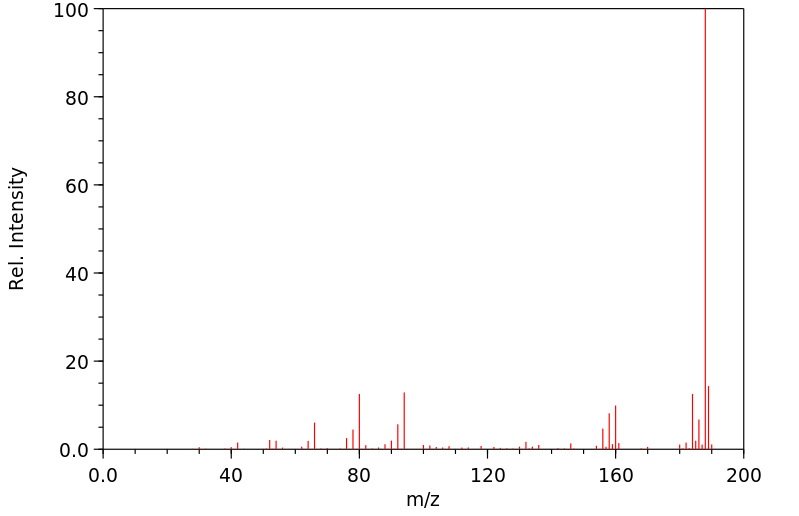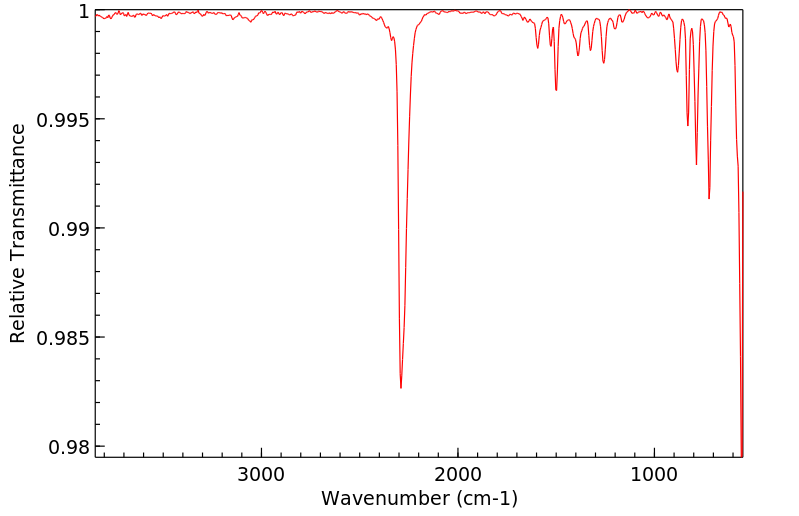蒽-d10 | 1719-06-8
中文名称
蒽-d10
中文别名
蒽-D10;蒽-D1
英文名称
anthracene-d10
英文别名
1,2,3,4,5,6,7,8,9,10-decadeuterioanthracene
CAS
1719-06-8
化学式
C14H10
mdl
——
分子量
188.154
InChiKey
MWPLVEDNUUSJAV-LHNTUAQVSA-N
BEILSTEIN
——
EINECS
——
-
物化性质
-
计算性质
-
ADMET
-
安全信息
-
SDS
-
制备方法与用途
-
上下游信息
-
文献信息
-
表征谱图
-
同类化合物
-
相关功能分类
-
相关结构分类
物化性质
-
熔点:210-215 °C (lit.)
-
沸点:340 °C (lit.)
-
闪点:121 °C
-
溶解度:氯仿(少量溶解)、乙酸乙酯(少量溶解)、甲醇(少量,加热并超声处理)
-
保留指数:1789.6;301.59
-
稳定性/保质期:
在常温常压下稳定,避免与氧化物和酸接触。
计算性质
-
辛醇/水分配系数(LogP):4.4
-
重原子数:14
-
可旋转键数:0
-
环数:3.0
-
sp3杂化的碳原子比例:0.0
-
拓扑面积:0
-
氢给体数:0
-
氢受体数:0
安全信息
-
危险品标志:Xi,T,N
-
安全说明:S23,S24/25,S26,S36/37,S53,S60,S61
-
危险类别码:R36/37/38
-
WGK Germany:2
-
海关编码:28459000
-
危险品运输编号:UN 3077 9
-
储存条件:2-8°C条件下,请密封保存。
SDS
| Name: | Anthracene-d10 Material Safety Data Sheet |
| Synonym: | |
| CAS: | 1719-06-8 |
Synonym:
Section 2 - COMPOSITION, INFORMATION ON INGREDIENTS
| CAS# | Chemical Name | content | EINECS# |
| 1719-06-8 | Anthracene-d10 | 98+% | 217-004-5 |
Risk Phrases: None Listed.
Section 3 - HAZARDS IDENTIFICATION
EMERGENCY OVERVIEW
Hygroscopic (absorbs moisture from the air).
Potential Health Effects
Eye:
May cause eye irritation.
Skin:
Causes mild skin irritation.
Ingestion:
The toxicological properties of this substance have not been fully investigated.
Inhalation:
May cause respiratory tract irritation. The toxicological properties of this substance have not been fully investigated.
Chronic:
Not available.
Section 4 - FIRST AID MEASURES
Eyes: Flush eyes with plenty of water for at least 15 minutes, occasionally lifting the upper and lower eyelids. Get medical aid.
Skin:
Get medical aid. Flush skin with plenty of water for at least 15 minutes while removing contaminated clothing and shoes.
Ingestion:
Get medical aid. Wash mouth out with water.
Inhalation:
Remove from exposure and move to fresh air immediately. If not breathing, give artificial respiration. If breathing is difficult, give oxygen. Get medical aid.
Notes to Physician:
Section 5 - FIRE FIGHTING MEASURES
General Information:
As in any fire, wear a self-contained breathing apparatus in pressure-demand, MSHA/NIOSH (approved or equivalent), and full protective gear. This material in sufficient quantity and reduced particle size is capable of creating a dust explosion.
Extinguishing Media:
Use water spray, dry chemical, carbon dioxide, or chemical foam.
Section 6 - ACCIDENTAL RELEASE MEASURES
General Information: Use proper personal protective equipment as indicated in Section 8.
Spills/Leaks:
Absorb spill with inert material (e.g. vermiculite, sand or earth), then place in suitable container.
Section 7 - HANDLING and STORAGE
Handling:
Avoid breathing dust, vapor, mist, or gas. Avoid contact with skin and eyes.
Storage:
Store in a cool, dry place. Store in a tightly closed container.
Store under nitrogen.
Section 8 - EXPOSURE CONTROLS, PERSONAL PROTECTION
Engineering Controls:
Use adequate ventilation to keep airborne concentrations low.
Exposure Limits CAS# 1719-06-8: Personal Protective Equipment Eyes: Not available.
Skin:
Wear appropriate protective gloves to prevent skin exposure.
Clothing:
Wear appropriate protective clothing to prevent skin exposure.
Respirators:
Follow the OSHA respirator regulations found in 29 CFR 1910.134 or European Standard EN 149. Use a NIOSH/MSHA or European Standard EN 149 approved respirator if exposure limits are exceeded or if irritation or other symptoms are experienced.
Section 9 - PHYSICAL AND CHEMICAL PROPERTIES
Physical State: Powder
Color: beige to slight yellow
Odor: Not available.
pH: Not available.
Vapor Pressure: Not available.
Viscosity: Not available.
Boiling Point: Not available.
Freezing/Melting Point: 218-220 deg
Autoignition Temperature: Not available.
Flash Point: 121 deg C ( 249.80 deg F)
Explosion Limits, lower: Not available.
Explosion Limits, upper: Not available.
Decomposition Temperature:
Solubility in water: Insoluble.
Specific Gravity/Density:
Molecular Formula: C14D10
Molecular Weight: 188.14
Section 10 - STABILITY AND REACTIVITY
Chemical Stability:
Stable under normal temperatures and pressures.
Conditions to Avoid:
Incompatible materials, light.
Incompatibilities with Other Materials:
Strong oxidizing agents, fluorine, acids (mineral, oxidizing, e.g.
chromic acid, hypochlorous acid, nitric acid, sulfuric acid), hypochlorite.
Hazardous Decomposition Products:
Carbon monoxide, carbon dioxide.
Hazardous Polymerization: Will not occur.
Section 11 - TOXICOLOGICAL INFORMATION
RTECS#:
CAS# 1719-06-8 unlisted.
LD50/LC50:
Not available.
Carcinogenicity:
Anthracene-d10 - Not listed by ACGIH, IARC, or NTP.
Section 12 - ECOLOGICAL INFORMATION
Section 13 - DISPOSAL CONSIDERATIONS
Dispose of in a manner consistent with federal, state, and local regulations.
Section 14 - TRANSPORT INFORMATION
IATA
No information available.
IMO
No information available.
RID/ADR
No information available.
Section 15 - REGULATORY INFORMATION
European/International Regulations
European Labeling in Accordance with EC Directives
Hazard Symbols: Not available.
Risk Phrases:
Safety Phrases:
S 24/25 Avoid contact with skin and eyes.
WGK (Water Danger/Protection)
CAS# 1719-06-8: No information available.
Canada
None of the chemicals in this product are listed on the DSL/NDSL list.
CAS# 1719-06-8 is not listed on Canada's Ingredient Disclosure List.
US FEDERAL
TSCA
CAS# 1719-06-8 is not listed on the TSCA inventory.
It is for research and development use only.
SECTION 16 - ADDITIONAL INFORMATION
N/A
制备方法与用途
根据提供的信息,以下是关于蒽的提取、精制和用途总结:
提取与精制 用途- 染料工业:用于制造分散染料、茜素还原染料。
- 涂料工业:作为油漆的原料之一。
- 塑料与绝缘材料:用作制造塑料及绝缘材料的基础原料。
- 有机工业:用于合成蒽醌类化合物。
- 半导体研究:在开发有机半导体方面有应用价值。
- 分析化学领域:
蒽是煤焦油中一个重要的组分,具有多种工业应用。在实际生产过程中,需要通过一系列复杂步骤从粗蒽中提取并精制出高质量的纯品。这些过程不仅涉及化学分离技术,还要求精细的操作和分析手段以确保最终产品的纯度与质量符合市场需求。
上下游信息
-
下游产品
中文名称 英文名称 CAS号 化学式 分子量 —— perdeuterio 9,10-dibromoanthracene 518292-58-5 C14H8Br2 343.962
反应信息
-
作为反应物:参考文献:名称:铬(iii)-超氧配合物通过质子耦合电子转移使蒽衍生物芳香羟基化†摘要:金属-超氧中间体的化学反应开始通过酶及其合成模型化合物进行氧化反应。然而,由金属-超氧物种进行的芳族羟基化反应尚未得到证实。在这项研究中,我们首次报道了单核非血红素Cr(III)-superoxo配合物[(Cl)(TMC)Cr III(O 2)] +(1)发生在三氟甲磺酸(HOTf)的存在下,通过速率确定从蒽到1的质子耦合电子转移(PCET),然后快速进一步氧化,得到蒽醌。根据马库斯电子转移理论,很好地分析了在HOTf存在下从蒽衍生物到1的电子转移速率常数。DOI:10.1039/c9cc03245b
-
作为产物:参考文献:名称:吡唑并吡啶酮配体实现芳烃的非定向 Pd 催化 C-H 全氘化和间位选择性烯基化摘要:配体的开发及其在催化循环中的作用的阐明是在非定向过渡金属催化的 C-H 功能化中实现高效率和选择性的关键。特别是,仔细的配体设计可以实现以前无法接近的底物位置的功能化,这可能导致常见反应物的区域发散转化。在这项研究中,开发了一系列可一步轻松制备的吡唑并吡啶酮 ( PzPyOH ) 配体,用于 Pd 催化的芳烃全氘化和间位选择性烯基化。在这个系统中,2-吡啶酮部分被合并以充当内部碱基,促进 C-H 裂解并使 C-H 激活可逆,即使在具有挑战性的 sp 2C-H 键,从而实现全氘化。此外,C-H 键的可逆激活意味着位点选择性是在烯基化反应的迁移插入步骤中确定的,因此优先功能化间位而不是通常更具反应性的邻位和对位-苯甲醚衍生物的位置。此外,吡唑部分的电子和结构特性为配体与 Pd 的结合提供了灵活性,使烯烃偶联伙伴在烯基化过程中能够轻松配位。在此过程中,吡啶酮和乙酸配体之间的氢键对于稳定中间体至关重要,允许不同类型的结合模式,包括DOI:10.1021/acscatal.2c06303
-
作为试剂:参考文献:名称:蒽与C 60之间一致的狄尔斯-阿尔德反应摘要:蒽通过二次同位素效应对蒽与C 60的狄尔斯-阿尔德反应进行了实验研究。逆α-次级同位素效应与β-次级同位素效应的统一值共同表明标题反应的协调机制。DOI:10.1016/s0040-4039(00)02211-5
文献信息
-
ORGANIC ELECTROLUMINESCENCE DEVICE AND ELECTRONIC APPARATUS PROVIDED WITH THE SAME申请人:IDEMITSU KOSAN CO., LTD.公开号:US20200111965A1公开(公告)日:2020-04-09An organic electroluminescence device including a cathode, an anode, and an emitting layer disposed between the cathode and the anode, wherein the emitting layer contains a compound represented by the following formula (1) and one or more compounds selected from the group consisting of compounds represented by formulas (11), (21), (31), (41), (51), (61), (71) and (81). In the formula (1), at least one of R 1 to R 8 is a deuterium atom.一种有机电致发光器件,包括阴极、阳极以及设置在阴极和阳极之间的发光层,其中该发光层包含以下式(1)所表示的化合物和从以下式(11)、(21)、(31)、(41)、(51)、(61)、(71)和(81)所表示的化合物组成的化合物中选择的一个或多个化合物。在式(1)中,R1至R8中的至少一个是氘原子。
-
ORGANIC ELECTROLUMINESCENT DEVICE申请人:SFC CO., LTD.公开号:US20200395553A1公开(公告)日:2020-12-17Disclosed is an organic electroluminescent device that employs a compound represented by Formula A-1 or A-2: and a compound represented by Formula B: The organic electroluminescent device has excellent luminescent properties such as high color purity and long lifetime.公开了一种使用由化合物A-1或A-2表示的化合物以及由化合物B表示的化合物的有机电致发光器件:所述有机电致发光器件具有优异的发光性能,如高色纯度和长寿命。
-
C−O Bond Homolysis in a Tungsten Alkoxide: The Mechanism of Alcohol Deoxygenation by WCl<sub>2</sub>(PMe<sub>3</sub>)<sub>4</sub> and WH<sub>2</sub>Cl<sub>2</sub>(PMe<sub>3</sub>)<sub>4</sub>作者:Thomas J. Crevier、James M. MayerDOI:10.1021/ja970929s日期:1997.9.1Reactions of alcohols with WCl2(PMe3)4 (1) or WH2Cl2(PMe3)4 (2) yield W(O)Cl2(PMe3)3 (3), PMe3, and hydrocarbons. Cyclopropanemethanol is deoxygenated to give 1-butene and a trace of trans-2-butene as the organic products; benzyl alcohol yields toluene and bibenzyl. These products indicate the intermediacy of organic radicals. Benzyl radicals in the reaction of 1 with PhCH2OH can be trapped by added醇与 WCl2(PMe3)4 (1) 或 WH2Cl2(PMe3)4 (2) 反应生成 W(O)Cl2(PMe3)3 (3)、PMe3 和碳氢化合物。环丙烷甲醇脱氧得到1-丁烯和微量的反式2-丁烯作为有机产物;苯甲醇生成甲苯和联苯。这些产物表明有机自由基的中间体。1 与 PhCH2OH 反应中的苄基自由基可以通过添加 2 或 9,10-二氢蒽 (DHA) 来捕获,导致甲苯与联苄的产率增加。与 WD2Cl2(PMe3)4 (2-d2) 或 DHA-d12 形成 PhCH2D。在 DHA 存在下,甲醇与 1 的反应类似地进行,形成 3 和甲烷。1 与苯甲醇反应的动力学研究表明,该反应通过醇盐中间体进行。这些结果表明了涉及醇盐中间体中 CO 键均裂的机制。讨论了这种不寻常转变的热力学。
-
Preparation and Structural Study of the Enantiomers of α,α‘-Bis(trifluoromethyl)-9,10-anthracenedimethanol and Its Perdeuterated Isotopomer, Highly Effective Chiral Solvating Agents作者:M. Pomares、F. Sánchez-Ferrando、A. Virgili、A. Alvarez-Larena、J. F. PiniellaDOI:10.1021/jo015957e日期:2002.2.1Enantiopure forms of alpha,alpha'-bis(trifluoromethyl)-9,10-anthracenedimethanol and the corresponding perdeuterated isotopomers were prepared. The conformational study was carried out by (1)H NMR, and the absolute configuration was determined by the X-ray study of the crystallized diastereoisomeric carbamate derivative. This compound was tested as a chiral solvating agent (CSA). The results showed
-
Importance of C*–H Based Modes and Large Amplitude Motion Effects in Vibrational Circular Dichroism Spectra: The Case of the Chiral Adduct of Dimethyl Fumarate and Anthracene作者:Marco Passarello、Sergio Abbate、Giovanna Longhi、Susan Lepri、Renzo Ruzziconi、Valentin Paul NicuDOI:10.1021/jp502544v日期:2014.6.19The role played by the C*–H based modes (C* being the chiral carbon atom) and the large amplitude motions in the vibrational absorption (VA) and vibrational circular dichroism (VCD) spectra is investigated. The example of an adduct of dimethyl fumarate and anthracene, i.e., dimethyl-(+)-(11R,12R)-9,10-dihydro-9,10-ethanoanthracene-11,12-dicarboxylate, and two deuterated isotopomers thereof specially研究了基于C * –H的模式(C *为手性碳原子)以及大振幅运动在振动吸收(VA)和振动圆二色性(VCD)光谱中的作用。富马酸二甲酯与蒽的加合物实例,即二甲基-(+)-(11 R,12 R考虑了为此目的专门合成的)-9,10-二氢-9,10-乙基蒽-11,12-二羧酸酯及其两个氘代异位异构体。通过比较未氘代和氘代物种的实验光谱和DFT计算光谱,我们证明VA和VCD光谱中的C * –H弯曲,摇摆和拉伸模式在定义明确的光谱特征中清晰可见。此外,通过分析指纹和C–H拉伸区域的VA和VCD数据,可以收集有关构象异构体分布的重要信息,尤其要注意带状数据。通过执行线性跃迁(LT)计算,已模拟了与两个甲氧基部分的大幅度运动有关的效应,它包括系统地改变两个甲氧基部分的相对位置,并计算以此方式获得的部分优化结构的VCD光谱。与实验结果相比,LT方法可以提高计算光谱的质量,尤其是在相对强度和带宽方面。
表征谱图
-
氢谱1HNMR
-
质谱MS
-
碳谱13CNMR
-
红外IR
-
拉曼Raman
-
峰位数据
-
峰位匹配
-
表征信息
同类化合物
齐斯托醌
黄决明素
马普替林相关物质D
马普替林杂质E(N-甲基马普替林)
马普替林杂质D
马普替林D3
马普替林
颜料黄199
颜料黄147
颜料黄123
颜料黄108
颜料红89
颜料红85
颜料红251
颜料红177
颜料紫27
顺式-1-(9-蒽基)-2-硝基乙烯
阿美蒽醌
阳离子蓝FGL
阳离子蓝3RL
长蠕孢素
镁蒽四氢呋喃络合物
镁蒽
锈色洋地黄醌醇
锂钠2-[[4-[[3-[(4-氨基-9,10-二氧代-3-磺基-1-蒽基)氨基]-2,2-二甲基-丙基]氨基]-6-氯-1,3,5-三嗪-2-基]氨基]苯-1,4-二磺酸酯
锂胭脂红
链蠕孢素
铷离子载体I
铝洋红
铂(2+)二氯化1-({2-[(2-氨基乙基)氨基]乙基}氨基)蒽-9,10-二酮(1:1)
钾6,11-二氧代-6,11-二氢-1H-蒽并[1,2-d][1,2,3]三唑-4-磺酸酯
钠alpha-(丙烯酰氨基)-[4-[[9,10-二氢-4-(异丙基氨基)-9,10-二氧代-1-蒽基]氨基]苯氧基]甲苯磺酸盐
钠[[3-[[4-(环己基氨基)-9,10-二氢-9,10-二氧代-1-蒽基]氨基]-1-氧代丙基]氨基]苯磺酸盐
钠[3-[[9,10-二氢-4-(异丙基氨基)-9,10-二氧代-1-蒽基]氨基]丁基]苯磺酸盐
钠6,11-二氧代-6,11-二氢-1H-蒽并[1,2-d][1,2,3]三唑-4-磺酸酯
钠4-({4-[乙酰基(乙基)氨基]苯基}氨基)-1-氨基-9,10-二氧代-9,10-二氢-2-蒽磺酸酯
钠2-[(4-氨基-9,10-二氧代-3-磺基-9,10-二氢-1-蒽基)氨基]-4-{[2-(磺基氧基)乙基]磺酰基}苯甲酸酯
钠1-氨基-9,10-二氢-4-[[4-(1,1-二甲基乙基)-2-甲基苯基]氨基]-9,10-二氧代蒽-2-磺酸盐
钠1-氨基-4-[(3-{[(4-甲基苯基)磺酰基]氨基}苯基)氨基]-9,10-二氧代-9,10-二氢-2-蒽磺酸酯
钠1-氨基-4-[(3,4-二甲基苯基)氨基]-9,10-二氧代-9,10-二氢-2-蒽磺酸酯
钠1-氨基-4-(1,3-苯并噻唑-2-基硫基)-9,10-二氧代蒽-2-磺酸盐
醌茜隐色体
醌茜素
酸性蓝P-RLS
酸性蓝41
酸性蓝27
酸性蓝127:1
酸性紫48
酸性紫43
酸性兰62








